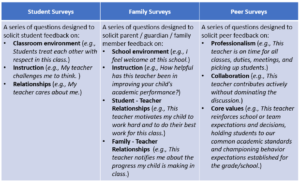Posts Tagged ‘Family Surveys’
Put Excellence at the Heart of Performance Management
Performance management, at its core, sets expectations. It puts a stake in the ground for what “good” looks and sounds like in the classroom and serves as the baseline of teacher observation rubrics. Effective performance management is more than diagnosing current performance; it supports teachers to articulate an actionable, clear trajectory toward excellence. Ultimately, a vision of good teaching and learning must be at the heart of any performance management system.
Common Pitfall: Framework Without Vision
Too often schools and districts launch a performance management system by creating or selecting a rubric without consideration of core instructional priorities. Enthusiasm and urgency, while helpful, can lead to less than ideal system design.
For example, simply adopting an existing framework because it is “proven” or “research-based” might not actually lead schools and teachers to excellence: what might be excellent teaching in one context might not be true in another setting. Creating a framework from scratch in a vacuum, separate from instructional priorities, isn’t likely to lead teachers to excellence either.
This doesn’t mean that adopting an existing framework is the wrong strategy, or that creating something new won’t get leaders and teachers where they need to be. It does mean, though, that this work must be grounded in the core realities of instruction necessary to move kids.
Ground Performance Management in a Vision for Excellent Instruction
Co-design and co-own by instructional leaders. Defining excellence for as complex a role as teaching requires a team of individuals, with different areas of expertise and focus. While very often, the development of teacher evaluation systems lives within talent/human resources, great systems strategically draw in additional stakeholders. For quality operations, a talent leader should drive and own the design and implementation of a performance management framework. At the same time, this work should be a shared priority between leaders of talent, academics and school management functions in a network or district. Instructional leaders working in schools daily must be the core authors and implementers of expectations for teachers.
Measure what matters. If teachers are held to expectations through a framework that aligns with core instructional priorities, schools are more likely to see improvement in the areas that matter most for students. If a solid instructional vision grounds all decision making, then curricular resources, training, and other supports will naturally stem from that vision. As teachers are supported to meet expectations via appropriate the resources, materials, and training, student learning will flourish.
Lead from your vision. Consider the following questions, and strategically engage others to ensure answers reflect the perspectives of a broad range of stakeholders:
- What are our prevailing beliefs within our system about students, and the role teachers play in their success?
- What do the instructional standards require from our students? And then, by extension, from our teachers?
- In classrooms where good teaching and learning is happening, what are teachers doing? What are students doing?
- How does this differ for different students? Different contexts?
- How do we ensure that the performance management system we design reflects our vision of excellent teaching?
- Who will own this work? How will we ensure that leaders from talent and instruction both continue to be involved?
Let us know what you think in the comments below!
-Jessica
Designing Evaluation Frameworks with Development at the Core – Part III: Amplifying Stakeholder Voice with Surveys
This post is the third in a series on how innovators are reimagining the design and implementation of evaluation and development frameworks. Read our earlier posts on observation frequency and raising rubric rigor.
When you think of a teacher, where are they? What are they doing? If you envisioned someone standing in front of a blackboard, lecturing a group of students, you’re likely not alone. In reality however, teachers spend their days in a multitude of ways: working individually with students, collaborating with peers, planning independently, connecting with parents and family members.
Definitions of excellent teaching therefore must go beyond classroom observations and measures of student outcomes (both of which are important!), to gather a broader view of a teacher’s impact.
Surveys are a simple, yet powerful tool that can amplify the voices of stakeholders from across a school community to help educators develop a comprehensive view of excellence.
The Benefits of Administering Surveys
- Surveys, coupled with other measures like classroom observations, provide rich information to help teachers improve their practice. Teaching is a complex job that depends on strong relationships. While districts and schools have made progress in collecting data and providing feedback on certain aspects of the profession (e.g., content knowledge, teaching strategies, assessment data), our field often misses the opportunity to coach teachers on their relationship building with students, families and peers.
- Research says that students are reliable evaluators of a teacher’s impact. Analysis by the Measures of Effective Teaching (MET) project finds that teachers’ student survey results are predictive of student achievement gains. In other words, students know an effective classroom when they experience one.
- Surveys provide the opportunity to put values into practice. Value statements like “we are a team and family” or “parents are partners” are powerful; however, these beliefs are only as true as the actions taken to build an authentic community. Administering surveys of key stakeholders sends a strong message that the voices of community members are valued, respected and heard.
- Surveys provide clear and transparent expectations to teachers. When questions are shared with teachers in advance, the survey content provides clear definitions for expected behaviors in teacher-to-teacher, teacher-to-student, and teacher-to-family relationships. For example, if a survey asks families if they receive one or more positive phone calls a month from their child’s teacher, that sets a very clear expectations for the teacher-family relationship.
Survey Types
Educators have available a number of survey types, structures, question formats and administration platforms.The table below highlights three common survey types.
Surveys should be designed thoughtfully, taking into consideration the purpose, audience, and respondents.
- Purpose – Why are you administering the survey? What do you hope to learn? How will results be utilized?
- Audience – Who will analyze and interpret the survey results? When and how will they reflect on and plan from the results? How will the results be debriefed with teachers to improve practice?
- Respondents – Who will complete the survey? When and how will they complete the survey? What directions, supports and technology will be necessary for administration?

To learn more, including a list of sample survey questions, visit the resources page of our website.


